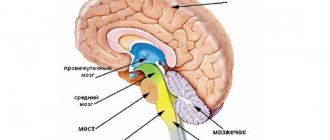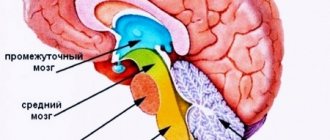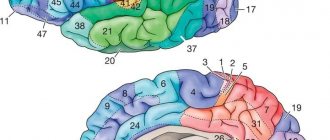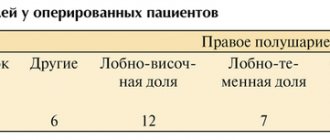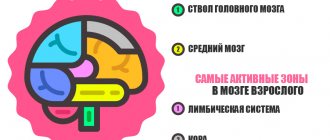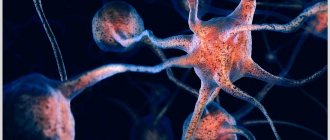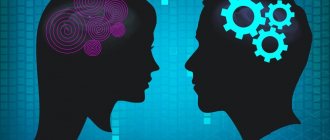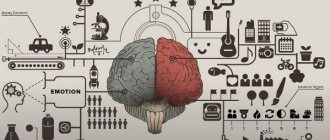General information
Formed from the anterior end of the primary neural tube.
In embryogenesis, it is divided into 2 parts, one of which gives rise to the telencephalon, the second - the intermediate brain. According to Alexander Luria’s model, it consists of 3 blocks:
- Block regulating brain activity levels. Ensures the implementation of certain types of activities. Responsible for emotional reinforcement of activity based on predicting its results (success - failure).
- Block for receiving, processing and storing incoming information. Participates in the formation of ideas about ways to implement activities.
- Block of programming, regulation and control over the organization of mental activity. Compares the resulting result with the original intent.
The forebrain takes part in the work of all blocks. Based on information processing, it controls behavior. Administrator of higher psychological functions: perception, memory, imagination, thinking, speech.
Structure and composition
Traditionally, there are five large parts of the brain: the pons, the cerebellum, the medulla oblongata, the midbrain and the cerebral hemispheres. But there is another method of separation. It includes the concepts of brainstem, hindbrain, midbrain and forebrain. The latter is precisely of the greatest interest, since it developed last - in lower vertebrates such division into hemispheres is not observed.
The composition of the brain is quite simple. More than half of its substance consists of water. The rest is lipids, minerals and proteins. It’s even strange what a trivial chemical composition such a complex organ as the brain has.
Anatomy
The structure of a living individual is not easy to describe. Especially such a component as the brain. This universe that exists in everyone continues to hide its secrets. But this does not mean that they are not worth understanding.
Development
The forebrain is formed at 3-4 weeks of prenatal development. By the end of the 4th week of embryogenesis, the telencephalon, diencephalon, and the cavity of the third ventricle are formed from the forebrain.
Diencephalon
It consists of the thalamic and hypothalamic regions, which are located on the sides of the third ventricle between the hemispheres and the midbrain.
The thalamic region unites:
- The thalamus is an ovoid formation located deep under the cerebral cortex. The oldest, largest (3-4 cm) formation of the diencephalon;
- The epithalamus is located above the thalamus. It is famous for the fact that it contains the pineal gland. Previously, it was believed that the soul lived here. Yogis associate the pineal gland with the seventh chakra. By awakening the organ, you can open the “third eye”, becoming clairvoyant. The gland is tiny, only 0.2 g. But the benefits for the body are enormous, although previously it was considered a rudiment;
- subthalamus - a formation located below the thalamus;
- metathalamus - bodies located in the posterior part of the thalamus (previously considered a separate structure). Together with the midbrain, they determine the work of the visual and auditory analyzers;
The hypothalamic region includes:
- hypothalamus. Located under the thalamus. Weighs 3-5 g. Consists of specialized groups of neurons. Connected with all departments. Controls the pituitary gland;
- the posterior lobe of the pituitary gland is the central organ of the endocrine system, weighing 0.5 g. Located at the base of the skull. The posterior lobe, together with the hypothalamus, forms the hypothalamic-pituitary complex, which controls the activity of the endocrine glands.
Finite brain
Unites:
- cortical hemispheres. The bark appeared late in the development of the animal world. Occupies half the volume of the hemispheres. Its surface can exceed 2000 cm2;
- corpus callosum - a nerve tract connecting the hemispheres;
- striped body. Located on the side of the thalamus. On a section it looks like repeating stripes of white and gray matter. Promotes regulation of movements, motivation of behavior;
- olfactory brain. Unites structures that differ in purpose and origin. Among them is the central section of the olfactory analyzer;
Forebrain and its structure
The forebrain is quite complex. Everyone knows it very well, and when we mention this organ, a picture of two hemispheres immediately comes to mind. It's right. Gray matter is divided into sections: the cerebral hemispheres and the diencephalon. If we talk about a more detailed division and go deeper into this topic, we can single out: the basal ganglia, the cerebrum, the hippocampus and the limbic system - a complex that consists of structures responsible for visceral, motivational and emotional sensations. Such a fairly extensive structure of the human forebrain will be of little interest to a person far from medical science, so in this article we will refer to the first classification and talk about the structure of which in more detail.
Useful to know: Midbrain: structure, functions, development
to contents ^
Anatomical features
Intermediate
The thalamus is egg-shaped and gray-brown in color. Structural unit - nuclei, which are classified according to functional and compositional characteristics.
The epithalamus consists of several units, the most famous of which is the grayish-reddish pineal gland.
The subthalamus is a small region of gray matter nuclei connected to white matter.
The hypothalamus consists of nuclei. There are about 30 of them. Most are paired. Classified by location.
Posterior lobe of the pituitary gland. The pituitary gland is a round-shaped formation, the location is the pituitary fossa of the sella turcica.
Finite
Unites the hemispheres, corpus callosum and striatum. The largest department by volume.
The hemispheres are covered with gray matter 1-5 mm thick. The mass of the hemispheres is about 4/5 of the mass of the brain. Convolutions and grooves significantly increase the area of the cortex, containing billions of neurons and nerve fibers arranged in a certain order. Underneath the gray matter lies white matter—the processes of nerve cells. About 90% of the cortex has a typical six-layer structure, where neurons are connected through synapses with each other.
From the point of view of phylogenesis, the cerebral cortex is divided into 4 types: ancient, old, intermediate, new. The main part of the human cortex is the neocortex.
The corpus callosum is shaped like a wide strip. Consists of 200-250 million nerve fibers. The largest structure connecting the hemispheres.
Components and its functions
Hemispheres of the brain. Some of the important components that are separated by the posteroanterior cavity. The parts are connected by the corpus callosum - this is a white wall. The upper ball itself is covered with a shell of neurons and gray matter, arranged in columns in several layers. The surface of the hemispheres has the form of folds, convolutions and depressions, which are called grooves. It is these depressions that divide the brain into the temporal, frontal, parietal and occipital parts. They are named after the bones they are adjacent to. In neurons, the analysis of nerve connections that come from outside is carried out, these are visual, auditory, and neurons responsible for muscle activity. Gustatory and olfactory neurons are located in the temporal lobe, while behavioral neurons are located in the anterior gray matter. The central zone is responsible for human activity.
The main feature of the hemispheres is that they differ significantly from each other. For right-handed people, the neurons responsible for speech are located in the left hemisphere, and the right hemisphere is responsible for actions, logical chains, recognition of faces, songs, paintings and other things. Under the influence of external stimuli, experience is created and accumulated. In the hemispheres, to summarize and say briefly, the main centers are formed that interact with the most complex patterns of behavior, instincts and memory.
The diencephalon consists of three parts: lower, upper and central. Everyone has heard the word thalamus at least once - this is precisely the upper part of the diencephalon. It, in turn, is made up of the ventricle and paired formations. This is where all information from outside comes in, the initial assessment takes place and then passes further into the cortex of the human intellect. The hypothalamus is the lower part, which performs the function of metabolism and regulates brain energy. In the centers of the hypothalamus there are nuclei that are responsible for various sensations. In combination with the components of gray matter in impulses supplied for motor activity.
Useful to know: How the diencephalon functions and why it is needed
to contents ^
Functions
Mission – organization of mental activity.
Intermediate
Participates in coordinating the work of organs, regulating body movement, maintaining temperature, metabolism, and emotional background.
Thalamus . The main task is to sort information. It works like a relay - it processes and sends data coming from receptors and pathways to the brain. The thalamus affects the level of consciousness, attention, sleep, wakefulness. Supports speech functioning.
Epithalamus . Interaction with other structures occurs through melatonin, a hormone produced by the pineal gland in the dark (therefore, it is not recommended to sleep in the light). A derivative of serotonin - the “happiness hormone”. Melatonin is a participant in the regulation of circadian rhythms, being a natural sleep aid, it affects memory and cognitive processes. It affects the localization of skin pigments (not to be confused with melanin), puberty, and suppresses the growth of a number of cells, including cancer cells. Through connections with the basal ganglia, the epithalamus participates in the optimization of motor activity, and through connections with the limbic system, in the regulation of emotions.
Subthalamus . Controls the body's muscle responses.
Hypothalamus . Forms a functional complex with the pituitary gland and directs its work. The complex controls the endocrine system. The hormones it produces help cope with distress and maintain homeostasis.
Thirst and hunger centers are located in the hypothalamus. The department coordinates emotions, human behavior, sleep, wakefulness, and thermoregulation. Endorphins similar in action to opiates are found here, which help to endure pain.
Finite brain
Hemispheres
They act together with subcortical structures and the brain stem. Main destination:
- Organization of interaction of an organism with the environment through its behavior.
- Consolidation of the body.
Corpus callosum
The corpus callosum received attention after operations to dissect it in the treatment of epilepsy. The operations relieved seizures while changing a person’s personality. It was found that the hemispheres are adapted to work independently. However, to coordinate activities, information exchange between them is necessary. The corpus callosum is the main transmitter of information.
Striatum
- Reduces muscle tone.
- Contributes to the coordination of internal organ function and behavior.
- Participates in the formation of conditioned reflexes.
The olfactory brain contains centers that control the sense of smell.
Cerebral cortex
Head of mental processes. Controls sensory and motor functions. Consists of 4 layers.
The ancient layer is responsible for elementary responses (for example, aggression) characteristic of humans and animals.
The old layer is involved in the formation of attachment and laying the foundations of altruism. Thanks to the layer we are happy or angry.
The intermediate layer is a formation of a transitional type, since the modification of old formations into new ones is carried out gradually. Ensures the activity of the new and old cortex.
The neocortex concentrates information from subcortical structures and the brainstem. Thanks to it, living beings think, talk, remember, and create.
5 cerebral lobes
The occipital lobe is the central section of the visual analyzer. Provides visual pattern recognition.
Parietal lobe:
- controls movements;
- orients in time and space;
- provides perception of information from skin receptors.
Thanks to the temporal lobe, living things perceive a variety of sounds.
The frontal lobe regulates voluntary processes, movements, motor speech, abstract thinking, writing, self-criticism, and coordinates the work of other areas of the cortex.
The insula is responsible for the formation of consciousness, the formation of an emotional response and the maintenance of homeostasis.
